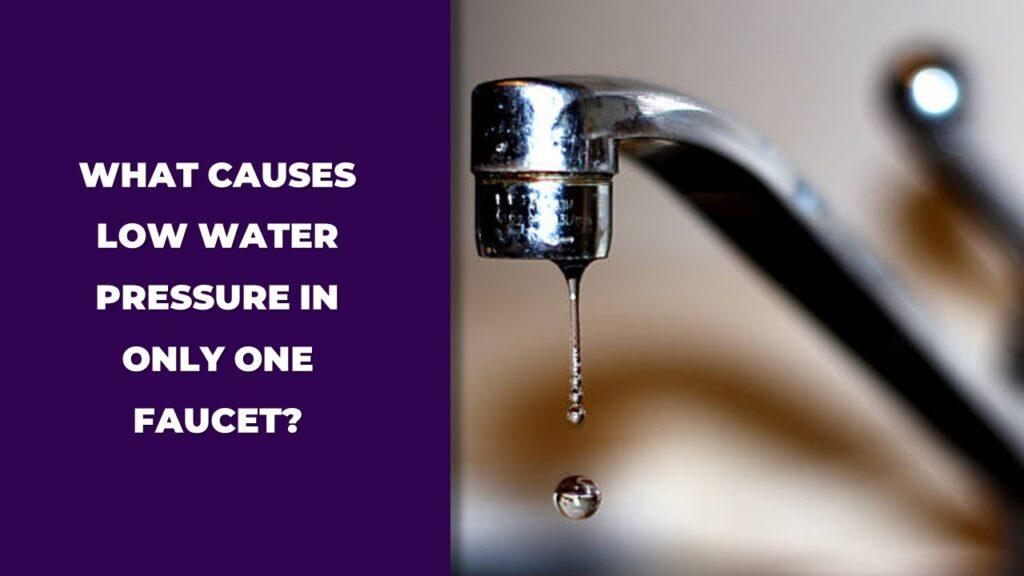
Low water pressure in only one faucet usually happens when the aerator is clogged, the cartridge is faulty, the shut-off valve is partially closed, or the supply line is kinked. The aerator mixes air with water, and minerals can clog it. The cartridge controls water flow and can wear out over time. A shut-off valve that’s not fully open limits pressure, and a bent supply line can block water.
In this article, we are going to cover these causes, how to check them, and simple fixes you can do at home to restore your faucet’s water pressure.
What Causes Low Water Pressure in Only One Faucet? (Main Reasons)
The main causes of low water pressure in only one faucet are:
- A clogged aerator at the faucet’s tip
- A worn-out or blocked faucet cartridge
- A shut-off valve that isn’t fully open
- A kinked or twisted supply line under the sink
- Sediment or debris stuck inside the faucet body
- A blockage in the pipe that feeds the faucet
- Hot water issues, like sediment in the water heater or a partially closed valve
When your faucet suddenly feels like it’s taking forever to fill a cup, it’s frustrating, right? The good news is that low water pressure in only one faucet usually points to a small, local issue—something you can often check and fix yourself. The usual suspects are the aerator, cartridge, shut-off valve, or a kinked supply line. Sometimes, it’s a bit deeper, like a clogged pipe or a problem with your hot water supply.
Let’s take a closer look at what’s happening behind the scenes and how you can tackle it step by step.
Clogged Aerator
This is probably the most common reason for low pressure in a faucet. The aerator is the small screen where the water comes out. It’s there to mix air with water, but it also traps tiny bits of minerals and debris over time, especially if you have hard water. When it gets clogged, the water can spray unevenly, dribble, or slow down to a trickle. The fix? It’s as simple as unscrewing the aerator, soaking it in vinegar to break up the gunk, and scrubbing it with an old toothbrush.
Clogged or Damaged Faucet Cartridge
The cartridge is the part inside your faucet that controls water flow when you turn the handle. It wears out over time or gets blocked by mineral deposits, especially if you have hard water. You might notice the pressure drops, the handle feels stiff, or the hot and cold mix isn’t right. If the aerator is clean but your faucet still has low pressure, the cartridge is the next thing to check. Swapping it out usually brings the pressure back.
Partially Closed Shut-Off Valve
This one’s easy to overlook. Every faucet has shut-off valves under the sink—one for hot water and one for cold. If someone closed it a little during a repair or cleaning, it can restrict the flow. It’s a quick fix: just turn the valve all the way open and test the faucet again.
Kinks or Obstructions in Supply Lines
It’s easy to accidentally pinch or bend the flexible supply lines under your sink, especially if you’ve been moving things around down there. A sharp kink can cut the water flow way down. Sometimes the lines also wear out with age and start to clog. Check under your sink—if a hose looks twisted or flattened, straighten it out or replace it.
Sediment or Debris Inside the Faucet Body
If you’ve cleaned the aerator and checked the cartridge, but your faucet is still weak, the problem might be inside the faucet itself. Sediment from hard water or old pipes can collect inside, restricting flow. It takes a little more work to take apart the faucet and clean it out, but it’s often the fix when the usual steps don’t work.
Localized Pipe Blockage
When the problem is just in one faucet, and everything else in the house is fine, you could be dealing with a clogged pipe that feeds that faucet. This can happen in older homes where pipes corrode or in areas with mineral-heavy water. If you’ve checked everything else and the problem sticks around, it’s time to call a plumber to inspect the pipes.
Specific Issues With Hot Water Pressure
If the low pressure is only on the hot side, it’s a different story. The problem might be a partially closed hot water shut-off valve, sediment buildup in your water heater, or a clog in the hot water line. Check whether it’s just hot water that’s slow—if so, you may need to flush the water heater or call a pro to take a closer look. Learn more about faucet components like metering cycles and how they affect water flow in different faucets.
Step-By-Step Troubleshooting Guide For Low Water Pressure In One Faucet
Here’s a simple step-by-step guide to fixing low water pressure in just one faucet:
- Take off the aerator and give it a good clean
- Check that the shut-off valve under the sink is fully open
- Inspect the faucet cartridge for wear or clogs
- Look for kinks or damage in the supply lines
- Flush the faucet and pipes to clear out any gunk
- If that still doesn’t do it, you might need a plumber to check for a deeper blockage
Got a slow faucet? Don’t stress, it’s usually something small you can handle without calling for backup. Let’s walk through the most common fixes together.
Step 1: Remove And Clean The Aerator
This is where you start. The aerator is that little screen at the end of the faucet. It’s like a mini filter, but over time, it can get clogged with minerals and gunk. Just unscrew it with your hand (or a soft cloth if it’s tight). If it’s really stuck, grab a pair of pliers, but wrap a rag around it first to avoid scratches. Soak the aerator in white vinegar for 15–20 minutes, then give it a good scrub with an old toothbrush. Put it back on and see if the pressure improves. Sometimes, that’s all it takes.
Step 2: Check The Shut-Off Valve
Take a look under your sink—see those little valves connected to the water lines? They control how much water flows to the faucet. Sometimes, they aren’t fully open. It could’ve happened after a repair, or someone may have turned it down and forgotten. Turn the valve all the way to the left, then check the faucet again. If the water comes back strong, you’re good to go.
Step 3: Inspect The Faucet Cartridge
If the aerator and shut-off valve check out, it’s time to look inside the faucet. The cartridge is the part that controls the water flow when you move the handle. If it’s clogged or worn out, you’ll notice pressure problems. Turn off the water supply, take the faucet apart, and pull out the cartridge. If it looks gunky or damaged, you’ll need a new one. Just make sure to get the right size for your faucet model—faucet parts aren’t one-size-fits-all.
Step 4: Check For Kinked Or Damaged Supply Lines
Next, take a peek under the sink at the water supply lines. Sometimes, they get kinked when you’re storing stuff down there, or they get twisted over time. If you see a sharp bend, straighten it out. If the lines look old, cracked, or rusty, it’s a good idea to replace them. A bad supply line can cause more problems than just low pressure, so it’s better to catch it early. f you want to upgrade your kitchen, take a look at our collection of high-end kitchen faucets that combine style with performance.
Step 5: Flush The Faucet And Lines
If you’re still dealing with low pressure, it might be a case of debris hiding in the pipes. To flush it out, turn off the water, disconnect the supply lines, and hold them over a bucket. Turn the water back on for a few seconds and let it flow out. This clears any loose gunk that might be stuck. Then reconnect everything, turn the faucet on, and check if the pressure is better.
Step 6: Look For Signs Of Deeper Pipe Problems
Tried everything and still no luck? If the faucet is still running slow after all these steps, the issue could be a blockage deeper in the plumbing. It might be a buildup of minerals, rust, or even a partial clog in the pipes that feed that faucet. This is when it’s smart to call a plumber. They can check the pipes, use tools like a camera or a snake, and figure out what’s going on.
When to Call a Plumber?
If you’ve cleaned the aerator, checked the shut-off valve, replaced the cartridge, flushed the lines, and your faucet still has low water pressure, it’s time to call a plumber.
Most problems that cause low water pressure in only one faucet are easy enough to handle on your own. But sometimes, the issue is buried deeper in the plumbing—like a hidden pipe blockage, corrosion, or a leak you can’t see. If your faucet is still slow after trying the basics, a plumber can step in with tools and expertise you probably don’t have, like pipe cameras and professional-grade augers.
There are other signs that you need a plumber, too. If you notice water stains inside cabinets, a persistent drip that won’t stop, or a damp, musty smell under the sink, these are red flags. A plumber can check for hidden leaks, water damage, or pipe issues that could turn into a bigger problem if ignored. It’s always better to catch these things early before they lead to costly repairs.
How to Prevent Low Water Pressure in a Single Faucet
To prevent low water pressure in only one faucet, clean the aerator regularly, check the shut-off valves, inspect the supply lines, and keep an eye on your plumbing system for early signs of trouble.
The truth is, a lot of low water pressure issues start small—just a little buildup here, a sticky valve there. But left alone, they can turn into bigger headaches. Here’s how to stay ahead of it:
- Clean the aerator every few months. Unscrew it, soak it in vinegar, and scrub it clean. This helps prevent minerals from clogging it up, especially in areas with hard water.
- Turn the shut-off valves all the way open once in a while. This keeps them from sticking or getting partially closed without you noticing.
- Look under the sink now and then. Check the supply lines for any kinks, twists, or wear. If a line looks old or brittle, it’s smart to replace it before it fails.
- Flush your faucet and supply lines about twice a year. Disconnect the lines, let the water flow into a bucket for a few seconds, then reconnect. This helps clear out sediment that might slow things down.
- Watch for signs of hard water. If you see white spots on your fixtures, it’s a clue that hard water is leaving behind minerals. A water softener can help reduce buildup.
- Pay attention to changes in pressure. If the water starts slowing down, don’t wait—check the aerator and cartridge right away before it gets worse.
A little care goes a long way. Regular maintenance can keep your faucet flowing strong and save you from costly plumbing calls down the line.
Conclusion
Low water pressure in only one faucet is usually caused by something simple, like a clogged aerator, a worn-out faucet cartridge, a partially closed shut-off valve, or a kinked supply line. These are the most common reasons for low water pressure in one faucet, and the good news is, they’re often easy to fix yourself.
That said, some problems hide a little deeper. If the issue is inside the faucet body, or there’s a blockage in the pipe feeding the faucet, you might need to take things apart—or call a plumber to help. And when it’s only the hot water with low pressure, don’t forget to check your water heater or the hot water shut-off valve.
The bottom line? When you notice low water pressure in only one faucet, don’t ignore it. Start by checking the aerator, the cartridge, the shut-off valve, and the supply lines. These simple steps can save you time, stress, and money. And if the problem sticks around, call a plumber before it turns into something bigger.
FAQs About Low Water Pressure in One Faucet
Why is only one faucet in my house affected by low water pressure?
Low water pressure in one faucet usually means a local issue, like a clogged aerator, a faulty cartridge, a kinked supply line, or a partially closed shut-off valve under the sink.
Can a faucet’s internal parts cause low water pressure?
Yes, worn or blocked cartridges inside the faucet can slow the flow. Sediment can also build up in the faucet body, leading to reduced water pressure in just one faucet.
Does hard water cause low water pressure?
Absolutely. Hard water leaves behind minerals that can clog aerators, cartridges, and even the pipes. This buildup can gradually reduce the water pressure in your faucet.
Should I replace the faucet if the pressure stays low after cleaning?
Not always. Check the aerator, cartridge, shut-off valves, and supply lines first. If those are clear and the faucet still has low pressure, then replacing it might be the next step.
How do I know if it’s a problem with my pipes?
If your faucet is clean but still has low pressure, it could be a deeper issue like a blockage or corrosion in the pipe feeding that faucet. A plumber can help inspect and diagnose the problem.

Dylan Foster is a family man with years of hands-on experience in plumbing, household maintenance, and fixing everyday issues around the home. A former plumber, Dylan knows what it’s like to deal with tricky leaks, worn-out parts, and all the little problems that pop up in a house. From plumbing repairs to kitchen fixes and garden hose setups, he’s done it all. Dylan shares real-world solutions to help others keep their homes running smoothly and avoid costly mistakes.




